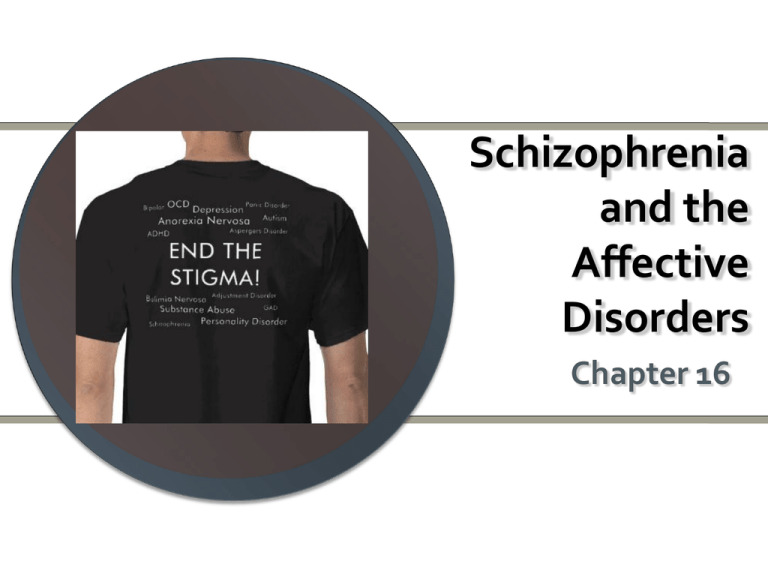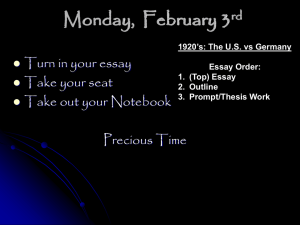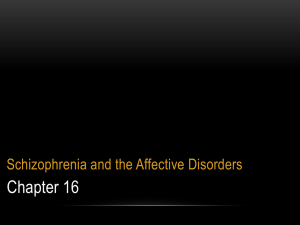
Schizophrenia
and the
Affective
Disorders
Chapter 16
See Table 16.1
Schizophrenia Symptoms
POSITIVE SYMPTOMS
Hallucinations
Auditory/olfactory
COGNITIVE SYMPTOMS
Attention
Low psychomotor speed
Delusions
Persecution/grandeur/control
Deficits in learning and memory
Thought disorders
Disorganized, irrational
Poor problem solving
Negative and Cognitive symptoms
are closely related, may involve
dysfunction in similar brain areas
Negative and Cognitive symptoms
are not specific to schizophrenia
Poor abstract thinking
NEGATIVE SYMPTOMS
Anhedonia
Flat affect
Motor Deficits
Little Speech (poverty of speech)
Social withdrawal
DOPAMINE &
POSITIVE SYMPTOMS
PROJECTIONS
Major CNS dopaminergic
systems include:
Nigrostriatal System
(role in movement)
POSITIVE SYMPTOMS
Mesolimbic Dopamine
VTA-amygdala
in reinforcement/reward)
Drugs that agonize DA
Mesolimbic System (role
Mesocortical System
(role in short-term
memory, planning, and
problem solving)
release (cocaine, etc.)
can also cause positive
symptoms of
schizophrenia
Brain Imaging
► Measure DA Rs in brains of recently diagnosed
schizophrenics not previously exposed to
neuroleptics
Radioactive ligand of the D2 R was injected iv & its
concentration measured in the corpus striatum
Two Results
► Brains of schizophrenics have an abnormally high #
of D2 Rs
► Higher level of occupancy of those Rs by DA
► Suggest both pre & postsynaptic abnormalities
Too much release & too many receptors
(modest)
Side-Effects of Long-Term AntiSchizophrenic Drugs
Similarly to long-term use of Parkinson’s drug treatments, there
can be side-effects with long-term use of anti-psychotic drugs.
Tardive Dyskinesia
Tardus – slow
Dyskinesia- faulty movement
Late-developing
TD: unable to stop moving
Supersensitivity: possible that DA receptors become
hypersensitive if they are blocked for long periods of time
D2 receptors in caudate and putamen
Problems with the D2 Theory
Schizophrenia associated with brain damage
Little damage to dopamine circuitry
Damage not explained by dopamine theory
It takes several weeks of neuroleptic therapy to
alleviate schizophrenic symptoms
Conventional neuroleptics (D2 blockers) mainly
effective for positive symptoms
Negative and cognitive symptoms might be caused
by brain damage
May be best to think of schizophrenia as multiple
disorders with multiple causes
Schizophrenia as a Neurological
Disorder
Predisposing factors (genetic, environmental, or both)
give rise to:
1. Abnormalities in both DA transmission and PFC
2. Abnormalities in DA transmission that cause
abnormalities in PFC
3. Abnormalities in PFC cause abnormalities in DA
transmission
Schizophrenia: Brain Abnormalities
Evidence of brain
damage
Negative and
cognitive
symptoms
Loss of brain
tissue
Lateral ventricles
more than twice
as large in
schizophrenic
patients than
control subjects
Possible Causes of Brain
Abnormalities
Epidemiological Studies
Season of birth
Viral epidemics
Population density
Prenatal malnutrition
Maternal stress
Possible Causes of Brain
Abnormalities
Season of birth (seasonality)
Late winter and early spring (northern hemisphere)
Reverse in southern hemisphere
Possible link: viruses
Effect seen in cities, not in countryside
See Figure 16.5
Possible Causes of Brain
Abnormalities
Vitamin D deficiency
Dealberto (2007)
Northern Europe: 3-fold increase in schizophrenia in immigrants
(equatorial regions)
Thiamine deficiency
Two-fold increase in incidence of schizophrenia in offspring of
women pregnant during severe food shortage in WWII (Germany and
Netherlands)
Maternal/paternal substance abuse – smoking
Complications during childbirth
Mother: Diabetes of mother, bleeding, preclampsia (high blood
pressure, protein in urine)
Other: oxygen or blood flow deprivation
Evidence for Abnormal Brain
Development
Home movies from families with schizophrenic child
Compared to normal siblings, schizophrenic child displayed
more negative affect and more abnormal movements
265 Danish children (11-13 years) were videotaped eating
lunch
Children who later developed schizophrenia displayed less
sociability and deficient psychomotor functioning
Hypothesis – although schizophrenia is not seen in
childhood, the early brain development of children who
become schizophrenic is not normal
Age of Onset
See Figure 16.8
Symptoms rarely begin before late adolescence or early adulthood
Progression:
Negative symptoms cognitive symptoms positive symptoms
Abnormal Brain Development
Brain damage is sudden (during
young adulthood)
Thompson et al. (2001)
Adolescence with early onset
schizophrenia
MRI
Normals:
Loss of 0.5-1.0%
Schizophrenic patients:
2-3%
Loss:
See Figure 16.9
Parietal to temporal lobe
Somatosensory and motor
Prefrontal cortex
Abnormal Brain Development
See Figure 16.10
Hypofrontality and Negative and Cognitive Symptoms
Decreased activity of the prefrontal cortex (dlPFC); believed to
be responsible for the negative symptoms of schizophrenia.
Above fig: Task required increased concentration and attention
Possibly caused by decreased DA activity in prefrontal regions
NMDA , Dopamine
and Hypofrontality
PCP and ketamine can cause
positive, negative and cognitivelike symptoms
NMDA receptor antagonists;
decrease DA and metabolic activity
in frontal cortex
Role of D2 Receptors in
Development of Schizophrenia
Abnormalities in the striatal DA system may be the cause
of schizophrenia
Virus inserted into striatum that increased D2 recpetors
Caused the development of behavioral deficits characteristic
of schizophrenia
Abnormal activity of dlPFC
Treatment with Partial DA
Receptor Agonists
Atypical drugs are able to
reduce ALL symptoms
Increase DA activity in PFC
Reduce DA activity in the NA
Aripoprazole: Atypical
Partial DA agonist
High affinity for receptor but
less than ligand
Can act like an antagonist
Nucleus accumbens
Can act like an agonist
Prefrontal cortex
http://www.youtube.com/watch?v=USxHsSWCaJA
AFFECTIVE
DISORDERS
Chapter 16
MAJOR AFFECTIVE DISORDERS
•
Bipolar Disorder – serious mood disorder
characterized by cyclical periods of mania and
depression.
•
•
•
•
Men and women in equal numbers
Mania: last days or weeks
Depression: typically 3x as long as manic episodes
Major Depressive Disorder – serious mood disorder
that consists of unremitting depression or periods of
depression that do not alternate with periods of
mania.
• Continuous
• Episodes
MAJOR AFFECTIVE DISORDERS
DEPRESSION
MANIA
Little energy
Move and talk slowly
May pace aimlessly and
restlessly
Cry
Anhedonia
Loss of appetite for food and
sex
Disturbed sleep
Depressed bodily functions
Sense of euphoria not justified
by circumstances
Nonstop speech and motor
activity
Delusions
Full of their own importance &
become angry or defensive if
contradicted
Long periods without sleep
Working on “unrealistic”
projects
Constipated
Decreased saliva production
Chen and Dilsaver (1996)
15.9% of people with MDD attempt to commit suicide
29.2% of people with BD attempt to commit suicide
AFFECTIVE DISORDERS: HERITABILITY
Evidence indicates a tendency for affective disorders to be
heritable, although many genes may be involved.
Monozygotic twins – 69%
Dizygotic twins – 13%
ANIMAL TESTS AND MODELS OF
DEPRESSION
Animal tests of depression
Forced swim test
Sucrose preference test (test of anhedonia)
Animal Models of depression
Learned helplessness
Social defeat
Copyright © Allyn & Bacon 2010
24
ANIMAL TESTS OF DEPRESSION
Porsolt swim test
•
measures the effect of antidepressant
drugs on the behaviour of rats/mice
Animals are subjected to two trials during which
they are forced to swim in an glass cylinder filled
with water
The first trial lasts 15 minutes.
24-hours later, a second trial is performed that lasts 5 minutes.
The time that the test animal spends without moving in the second trial is
measured.
Immobility time is decreased by antidepressants.
ANIMAL MODEL OF DEPRESSION
Social defeat
•
•
•
Repeated exposure to an aggressive male mouse
Decrease in subsequent social interaction
Increased time immobile in the forced swim test
Berton et al., 2006
BIOLOGICAL TREATMENTS
MDD
•
•
•
•
•
•
•
•
•
MOAIs
SSRIs & SNRIs
ECT
Transmagnetic stimulation (TMS)
Deep brain stimulation (DBS)
Vagus nerve stimulation
Low-dose Ketamine
Bright-light therapy (phototherapy)
Sleep deprivation
Bipolar Disorder
•
•
Lithium
Anticonvulsant drugs
BIOLOGICAL TREATMENTS
1950s
•
•
TB drugs found to elevate mood
First antidepressants
• MAO inhibitors
Monoamine oxidase (MAO) inhibitors
•
•
•
IPRONIAZID (e.g.)
MAO breaks down monoamines in the terminal buttons
Increases release of DA, NE and 5-HT (not specific)
MAO inhibitors: Cheese Effect
•
•
Dangerous dietary interaction
Excess tyramine hypertension
BIOLOGICAL TREATMENTS
Tricyclic
antidepressants
(TCAs)
•
•
•
E.g. Imipramine
Inhibits the reuptake of
norepinephrine and
serotonin but also
affects other
neurotransmitters.
Safer than MAOI’s
BIOLOGICAL TREATMENTS
‘Selective’ Reuptake
Inhibitors
•
•
•
SSRIs: serotonin
• Prozac, paxil
SNRIs: norepinephrine &
5-HT
•
Fewer side-effects
than TCAs
•
No more effective than
TCAs, but side effects are few
and they are effective at treating
other disorders
‘Selective’ is relative as they still have effects on both 5-HT and
NE though range in affinity:
•
Affinity for 5-HT:NE
• Milnacipran
1:1
• Venlafaxine
1:30
BIOLOGICAL TREATMENTS
MDD
•
•
•
•
•
•
•
•
•
MOAIs
SSRIs & SNRIs
ECT
Transmagnetic stimulation (TMS)
Treatment-resistant Depression
Deep brain stimulation (DBS)
Vagus nerve stimulation
Low-dose Ketamine
Bright-light therapy (phototherapy)
Sleep deprivation
Bipolar Disorder
•
•
Lithium
Anticonvulsant drugs
BIOLOGICAL TREATMENTS
Electroconvulsive Therapy
Early 1900s: von Meduna (drug induced)
1930s: Cerletti (electrical)
•
Electroconvulsive Therapy (ECT) – brief electrical shock,
applied to the head, that results in an electrical seizure; used to
treat depression.
•
Antidepressant effects are seen quickly (unlike
antidepressant drugs)
•
May exert effects through activation of inhibitory
neurotransmitter systems
•
•
Increased GABA & Neuropeptide Y
Potential cognitive impairments
TREATMENTS
•
Transmagnetic stimulation (TMS)
• Strong localized magnetic field into the brain by
passing an electrical current through a coil of wired
placed on the scalp
•
•
Deep brain stimulation (DBS):
• Subgenual ACC
•
•
•
•
1 month – 35% improvement, 10% remission
6 months – 60% improvement, 35% remission
NA
•
•
Response rate <30%
Reduce symptoms in ~50%
Vagus nerve stimulation
Low-dose Ketamine
33
MONOAMINE THEORY OF DEPRESSION
NORMAL
DEPRESSION
TREATED
Underactivity of serotonin and norepinephrine synapses
MONOAMINE THEORY OF DEPRESSION
Monoamine antagonists can produce the
symptoms of depression
•
Reserpine (lower blood pressure) – blocks the activity
that transporters that fill synaptic vesicles in
monoaminergic terminals with NTs
• Blocks release of NA and 5-HT
Monamine agonists treat depression
•
TCAs, SSRIs, SNRIs, MAOIs
Copyright (c) Allyn & Bacon 2010
35
PROBLEMS WITH THE MONOAMINE THEORY
OBSERVATIONS:
•
Depleting tryptophan from diet does not alter
mood in healthy volunteers
•
•
Does in others on antidepressant treatment
And in healthy people with family history of
depression
•
2-3 weeks for antidepressants to become
effective
•
Some people never respond to drug therapies
BRAIN REGIONS IN
AFFECTIVE DISORDERS
Amygdala: involved in the expression of
emotion
•
•
•
•
•
Negative emotion
50-75% blood flow and metabolism in amygdala
increases during depressive episodes
Abercrombie et al. (1998)
• Activity in amygdala of depressed patients
correlated with severity of depression
Metabolic activity of amygdala increases in
normal Ss when they look at faces with
expressions of sadness
Metabolic activity in amygdala increases when
depressed Ss remember episodes in their lives
that made them sad
BRAIN REGIONS IN
AFFECTIVE DISORDERS
Medial Prefrontal
Cortex:
•
•
Subgenual ACC lower
level of activation (right)
in depression
Increased during mania
Figure 16.19
THE ROLE OF THE 5-HT TRANSPORTER
5-HT transporter (5-HTT)
The promoter region that codes for the 5-HTT comes in
two forms:
Short
Long
Three possible
combinations:
S-S
S-L
L-L
The Role of the 5-HT Transporter
See Figure 16.20
Major depression
Suicide ideation
Caspi et al (2003) Science
847 people for 20 years
Stressful events (> # of stressful event; > depression)
Increase was greater for those with the short allele
THE ROLE OF THE 5-HT TRANSPORTER
Rausch et al. (2002)
•
People with 2 long alleles tend to respond better to drug
treatment
Lee et al. (2004)
•
Depressed people with 2 long alleles treated with
antidepressants have better long-term outcome
Rhodes et al (2007)
•
People with higher levels of 5-HT transporter in amygdala
showed less activation of the amygdala when the people looked
at emotional faces
Several meta-analyses of studies investigating
the role of 5-HTT promotor in depression
No significant effects!
ROLE OF NEUROGENESIS
•
•
•
•
•
Stressful experiences that produce depression (in animals) suppress
hippocampal neurogenesis
Administration of antidepressant treatments increases neurogenesis (in
animals)
Delay in action of antidepressant treatments = length of time it takes for
newborn neurons to mature
If neurogenesis is suppressed by low-level dose of radiation,
antidepressant drugs lose their effectiveness (in animals)
No way to measure adult human neurogenesis
ROLE OF CIRCADIAN RHYTHMS
Symptom of depression: disordered sleep
•
•
•
•
Reduced Sleep Latency
Reduced REM Latency
Reduced Slow-Wave Sleep
Increased Sleep Disruption
1 of the most effective antidepressant treatment –
sleep deprivation (total or REM selective)
•
•
•
REM selective - therapeutic effect occurs slowly, long-term
improvement after deprivation is discontinued
Total sleep deprivation – effects are immediate, but
depression returns the next day
Intermittent total sleep deprivation can have beneficial
results
SEASONAL AFFECTIVE DISORDER
Attacks of depression and lethargy typically
occur every winter
Cause:
Attacks are triggered by a reduction in
sunlight
•
•
Higher incidence in Northern US than in Florida
Light therapy is often effective in reducing symptoms









